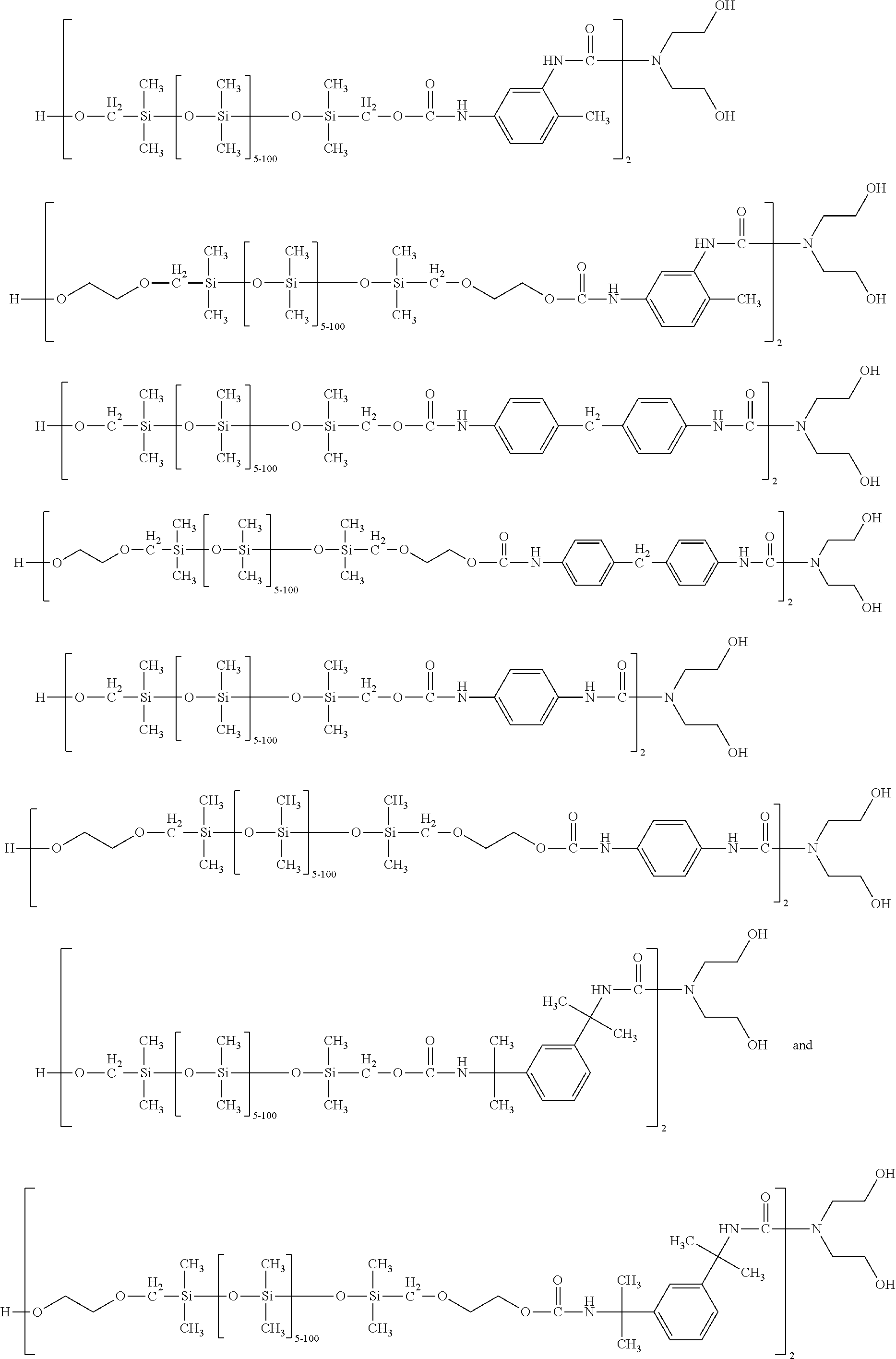Silicone-containing polyurethane foam
- Summary
- Abstract
- Description
- Claims
- Application Information
AI Technical Summary
Benefits of technology
Problems solved by technology
Method used
Image
Examples
##ventive example 1
Inventive Example 1
[0169]20.00 g of a linear organopolysiloxane of the formula HO—CH2—[Si(CH3)2—O]29Si(CH3)2—CH2—OH and 12.3 g of tolylene diisocyanate were reacted in 100 ml of absolute acetone under an atmosphere of argon. The reaction was catalyzed with 60 mg of bismuth(III) neodecanoate and stirred at 50° C. After a reaction time of 30 min, first 5.0 g of diethanolamine were gradually added dropwise and then the reaction mixture thus obtained was freed of solvent at a pressure of 10 hPa.
[0170]180.0 g of the organopolysiloxane thus obtained were initially emulsified with 600 mg of diazabicyclooctane, and 6.30 g of water into a homogeneous mixture using a high-speed stirrer and then 65.4 g of tolylene diisocyanate were added to this emulsion and incorporated with a high-speed stirrer for 10 s. Of the mixture thus obtained, 200 g were immediately introduced into a 4 L aluminum mold temperature controlled to 70° C. and the mold was closed for a period of 10 min except for a 100 μm w...
##ventive example 2
Inventive Example 2
[0171]200.00 g of a linear organopolysiloxane of the formula HO—CH2—[Si(CH3)2—O]29Si(CH3)2—CH2—OH and 12.3 g of tolylene diisocyanate were reacted without solvent under an atmosphere of argon. The reaction was catalyzed with 20 mg of bismuth(III) neodecanoate and stirred at 50° C. After a reaction time of 30 min, first 5.0 g of diethanolamine were gradually added dropwise and then the reaction mixture thus obtained was cooled to room temperature.
[0172]180.0 g of the organopolysiloxane thus obtained were initially emulsified with 600 mg of diazabicyclooctane and 6.30 g of water into a homogeneous mixture using a high-speed stirrer and then 65.4 g of tolylene diisocyanate were added to this emulsion and incorporated with a high-speed stirrer for 10 s. Of the mixture thus obtained, 200 g were immediately introduced into a 4 L aluminum mold temperature controlled to 70° C. and the mold was closed for a period of 10 min except for a 100 μm wide and 40 cm long slot to a...
##ventive example 3
Inventive Example 3
[0173]200.00 g of a linear organopolysiloxane of the formula HO—CH2—[Si(CH3)2O]29Si(CH3)2—CH2—OH and 12.3 g of tolylene diisocyanate were reacted without solvent under an atmosphere of argon. The reaction was catalyzed with 20 mg of bismuth(III) neodecanoate and stirred at 50° C. After a reaction time of 30 min, first 5.0 g of diethanolamine were gradually added dropwise and then the reaction mixture thus obtained was cooled to room temperature.
[0174]180.0 g of the organopolysiloxane thus obtained were initially emulsified with 600 mg of diazabicyclooctane and 7.20 g of water into a homogeneous mixture using a high-speed stirrer and then 73.2 g of tolylene diisocyanate were added to this emulsion and incorporated with a high-speed stirrer for 10 s. Of the mixture thus obtained, 180 g were immediately introduced into a 4 L aluminum mold temperature controlled to 70° C. and the mold was closed for a period of 10 min except for a 100 μm wide and 40 cm long slot to al...
PUM
| Property | Measurement | Unit |
|---|---|---|
| Fraction | aaaaa | aaaaa |
| Fraction | aaaaa | aaaaa |
| Density | aaaaa | aaaaa |
Abstract
Description
Claims
Application Information
 Login to View More
Login to View More - R&D
- Intellectual Property
- Life Sciences
- Materials
- Tech Scout
- Unparalleled Data Quality
- Higher Quality Content
- 60% Fewer Hallucinations
Browse by: Latest US Patents, China's latest patents, Technical Efficacy Thesaurus, Application Domain, Technology Topic, Popular Technical Reports.
© 2025 PatSnap. All rights reserved.Legal|Privacy policy|Modern Slavery Act Transparency Statement|Sitemap|About US| Contact US: help@patsnap.com



